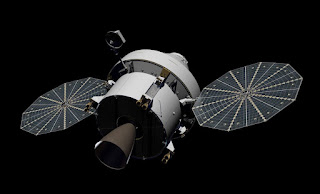How is a spacecraft propelled?
How is a spacecraft propelled?
The Sun,
batteries, or unstable atoms are the usual energy sources used by spacecraft,
while the re are other ones as well. Engineers analyze a space craft's intended
destination, intended use, and required operating time while determining the
appropriate sort of power for it.
Instruments on spacecraft allow them to capture
images and gather data while in orbit. However, in order to run those equipment
and transmit the data down to Earth, they require electricity.
What source does the power have?
The mission will determine the answer. Engineers must consider a number of factors while deciding on the optimal power system for a spaceship. They take into account things like the spacecraft's destination, intended use, and required operating time.The Sun is one energy source.
Sunlight energy (solar power)
A battery within the spaceship is charged by the electricity produced by the solar panels. Even when the spacecraft is moving away from the sun, these batteries can still keep it running.
On Mars, spacecraft have also been propelled by solar radiation. The Insight lander uses solar power just as the Mars Exploration Rovers, Spirit, Opportunity, and the Phoenix lander from NASA.
Spacecraft that are distant from the Sun have very huge solar panels to provide them with the energy they require. NASA's Juno mission, for instance, orbits Jupiter using solar energy the entire time. Three solar arrays on Juno each measure 30 feet (9 meters) in length.
Not all spacecraft, though, can run on solar power. One explanation is that solar power gets less effective the more away a spaceship is from the Sun. The climate and seasons of a planet, as well as harsh radiation, may potentially place restrictions on solar-powered explorers (a type of energy). Additionally, they might not be able to traverse arid, dark places like Moon caves.
Spacecraft must find alternative sources of electricity when solar power is unreliable. Therefore, researchers created alternative power sources for these spacecraft. One method is to just employ batteries, which can store energy for a spacecraft to use at a later time.
Powered by batteries
There are instances when missions are made to be completed quickly. For instance, the Huygens probe, which landed on Saturn's enormous moon Titan, was only intended to operate for a short period of time. As a result, a battery gave the lander the power it needed to function.Batteries for spacecraft are made to be durable. They must perform their duties in hostile circumstances in outer space and on the surfaces of other planets. Additionally, numerous recharges of the batteries are required. NASA researchers have developed techniques to make these batteries better over time. They may now last longer and store more energy in smaller spaces.
The power of atoms
A single atom is the smallest unit of matter. Atoms make up almost everything in the universe that we are aware of. To keep themselves together, atoms need to store a lot of energy. However, some atoms, known as radioisotopes, are unstable and start to disintegrate. Heat is produced as the atoms separate, releasing energy.The temperature difference between the unstable atoms' heat and the cold of space is used in radioisotope power systems to generate electricity. Numerous NASA missions have been propelled using this kind of equipment. For instance, it has propelled expeditions to Saturn and Pluto as well as interstellar spacecraft. The Curiosity rover on Mars likewise receives its power from a
Even in hostile locations, radioisotope systems may produce power for a very long time. The two Voyager spacecraft from NASA actually employ this kind of power. They have logged more miles than any other creation of humanity, and after more than 40 years in space, they are still sending data back!




Comments
Post a Comment